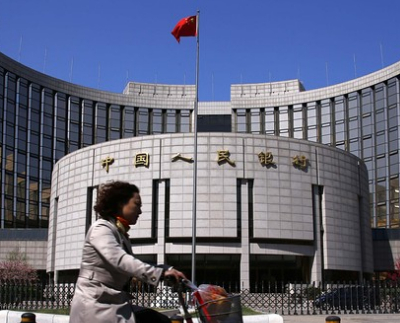(单词翻译:单击)
Shall I compare thee to a pain in my neck? Let me count the ways.
我该说你让我感觉如芒在背吗?让我细说一下理由。
Maybe the People's Bank of China wasn't quite that blunt in its 2014 China Financial Stability Report issued Tuesday. But when it came to talking about securities companies and how they help distort risks in the banking system, it certainly came close. The source of its ire? So-called 'directional asset management plans.'
或许中国央行在周二发布的《中国金融稳定报告(2014)》中没说得这么直截了当。但对于证券公司及其如何助长了银行体系的风险失真,中国央行显然说得够直白。中国央行为何感到不悦?是因为所谓的定向资产管理计划。

According to the report, the outstanding amount of directional asset management plans issued by securities companies at the end of 2013 was 4.83 trillion yuan ($790 billion), up a whopping 186% from a year earlier.
据该报告显示,截至2013年末,证券公司定向资产管理业务规模达人民币4.83万亿元(合7,900亿美元),较2012年末增长186%。
A glance at a number of banks' recent IPO prospectuses also shows just how prevalent these plans are. At the end of June, Bank of Chongqing held 3.86 billion yuan worth of such plans on their books compared with 1.11 billion yuan six months earlier. Harbin Bank held 16.3 billion yuan at the end of September, without giving a comparison.
一些银行最近的首次公开募股(IPO)招股说明书也显示出了定向资产管理计划有多盛行。截至去年6月底,重庆银行定向资产管理计划结余为人民币38.6亿元,2012年底为人民币11.1亿元。截至去年9月底,哈尔滨银行定向资产管理计划结余为人民币163亿元,但没有披露与之前进行比较的数据。
But what are they and why are they riling up the PBOC? Here's the definition from Harbin Bank:
但定向资产管理计划是什么,它们为何令中国央行感到不快?以下是哈尔滨银行给出的定义:
'W e enter into directional asset management contracts with securities companies and such securities companies are entrusted by us to provide loans to borrowers...secured by guarantees or by collateral. Directional asset management plans are not part of trust loans or the loan portfolio of our bank and are non-standard debt securities of our bank.'
根据定向资产管理计划,我们与证券公司签订定向资产管理合同,证券公司受我们的委托向借款人提供融资,资产管理安排由中国的金融机构予以担保,或由借款人提供担保物予以担保。定向资产管理计划不作为委托贷款或本行的贷款组合的一部分,而属于本行的非标准化债权证券。
Got it?
明白了吗?
Thankfully, if that isn't clear enough for you, the PBOC has provided an outline of exactly what these directional asset management plans are used for. And it's pretty clearly not happy about it.
幸运的是,如果你还不是很清楚,中国央行提供的参考中界定了这类定向资产管理计划的具体用途。很显然,中国央行对它并不是很满意。
1. Firstly, these plans allow banks to make off-balance-sheet loans. That process involves a bank entrusting its funds to a securities company, which then repackages it as an investment. Such an investment could involve buying a trust product (which banks aren't allowed to do directly anymore) that's backed by a loan to a company. Or it could involve buying the income stream from a company's accounts receivable, or investing in banker acceptance drafts, which would appear as loans on a bank's books, were the bank to discount them directly itself .
1. 首先,这些业务允许银行发放表外贷款。在这一过程中,银行把资金委托给一家证券公司,后者把资金重新打包成投资。这类投资可能涉及购买由公司贷款支持的信托产品(按照规定,银行不得直接购买这类信托产品),也可能涉及购买一家公司应收账款的现金流或是投资于银行承兑汇票,如果银行自己进行贴现,这些投资将在银行账面上显示为贷款。
Turning loans into investments also has the added advantage of turning interest income into fee income. Doing so makes it look as though the bank is diversifying its operations away from an over-dependence on lending, something regulators have been pushing for years
将贷款变成投资还有另外一个好处,那就是把利息收入转变为手续费及佣金收入。这样做让银行看起来是在推动业务多样化,不再过度依赖贷款,这正是监管机构多年来一直鼓励的做法。
2. One of the major limits on banks' operations is a loan-to-deposit ratio of 75%. That is, for every dollar a bank collects in deposits, it can only lend out 75 cents. One way to get around that limit is to shift lending off the books (see point one). The other way is to boost deposits. According to the PBOC's report, banks have been using securities companies to turn interbank deposits (which don't count toward their loan-to-deposit ratio) into ordinary deposits. They can do that by using the interbank deposits -- which come from other banks and financial institutions that trade in the interbank market -- to purchase wealth management products issued by insurance companies. The funds raised by the insurance company are then transferred back to the bank as ordinary deposits.
2. 75%的贷存比率是银行业面临的主要制约之一。也就是说,银行每收到一块钱存款,只能把七毛五分钱贷出去。规避这一限制的方法之一就是表外贷款(见第一点)。另一个方法是增加存款。根据中国央行的报告,银行一直在利用证券公司把银行间存款(不算入贷存比率)转变为普通存款。具体做法是用银行间存款(来自银行间市场的其他银行和金融机构)购买保险公司发行的理财产品,保险公司再将发行理财产品筹集的资金以普通存款的形式存入银行。
The central banks says in its report that, beyond help banking avoid regulatory requirements, directional asset management plans are spreading risk around the financial system. That's exacerbated by the fact that banks, securities companies and insurers are all kept separate under the purview of three different regulators. With the system growing more complicated, such complexities could mean gaps in oversight are opening up.
中国央行在报告中说,除了帮助银行规避监管要求外,定向资产管理业务正在金融系统中散播风险。而考虑到银行、证券公司和保险公司分归三个不同的机构监管,这样的风险又被放大。随着金融系统变得更加复杂,这样的复杂性意味着出现监管漏洞。


